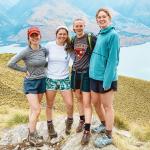Support
I began researching midwifery in my Women’s Health and Aging Class that I enrolled in for my public health minor. The class was taught by Leah Rohlfsen who became my advisor and my mentor for this research. I learned in this class that birthplace options have been a topic of discussion among women and healthcare professionals. I realized I had an amazing opportunity while studying abroad to learn about the birthing model in New Zealand.
In New Zealand, I learned more about, visited, and observed birthing homes. A birthing home is a place for a women to give birth where a midwife will be present and the woman giving birth has the autonomy to make her own decisions regarding medication, position, and delivery. I looked at how the rooms were set up focusing on presentation of medical equipment, the option for varying birthing positions, and dynamic of room including colors, bed structure, etc. I got to view two birthing centers (one urban and one rural). Surprisingly, I found that the rural birthing center that I visited was pretty similar to the urban birthing center. The biggest difference was that the urban birthing center was aesthetically more pleasing and the facility seemed newer.
Regardless that the amenities in the birthing homes are similar in urban and rural settings, I learned that there are still limited birthplace options for pregnant women living in rural areas. For example, some rural areas have been forced by the government to shut down a birthing unit. Most women cannot plan out the exact time they will give birth and do not want to wait until the last minute. This prompts them to travel to the nearest birthing home/hospital and pay to stay for housing for a prolonged period of time until they go into labor; this is costly and not practical for these women. Overall, through my research and visits, I learned more about the disadvantages rural areas face in terms of birthing options, particularly among people who reside in rural areas and the Māori people, the indigenous population.
When I unexpectedly had to return home due to COVID-19, I knew I wanted to somehow continue learning and complete my project. I applied and was awarded the Public Health Fellowship through St. Lawrence University to continue this research and extend it into a cross-cultural analysis between the birthing experiences in the United States and New Zealand. I am currently working on this research project, titled “Comparing Women’s Birth Experience and the Resulting Maternal Health Outcomes in the United States and New Zealand,” in hopes to submit for publication in the Fall. This all would not have been possible without the Travel Grant and the support from both the CIIS department and Leah Rohlfsen.
I feel so lucky to have had the opportunity to learn and develop in a new environment. I met incredible people, hiked tremendous peaks, and created memories that allowed me to grow not only as a student, but also as a person. I feel this experience abroad has pushed me to realize I am ready to pursue my passion in medicine.
